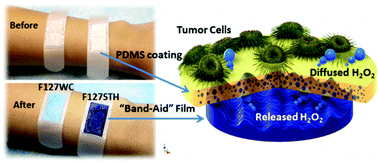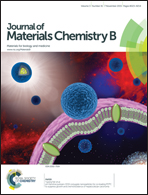Controlled H2O2 release via long-lived electron–hole separation mediated to induce tumor cell apoptosis
Abstract
Flexible films of polytungstate (PT) as active ingredients were fabricated in PDMS as a “band-Aid” to achieve controllable H2O2 release. In these different systems of an amorphous PT building block, the lengthened lifetime (bleaching process) of photo-electron–hole separation is attributed to the electron trapping of the PT network and the existence of hole scavengers. The hole scavengers further prevent recombination of electrons and holes, so that the long-lived photoelectron could provide sustainable reactive oxygen species (ROS) by trapped electrons. Transient absorption illustrates the kinetic competition between the process of photohole induced bleaching and coloration induced by weak irradiation, which suggests that the hole scavenger is vital for ROS generation. The signals of electron spin resonance further confirm the existence of ROS. The profiles of controllable H2O2 with various release efficiency were obtained via fluorescence studies. The results indicate that the H2O2 release efficiency is related to both the hole scavenger and the tungstate cluster. The released H2O2 on the responses of tumor cells were evaluated. Compared with a cancer drug, the controllable and reversible released H2O2 delivery is highly efficient in preventing the proliferation and inducing apoptosis of A375 melanoma cells.


 Please wait while we load your content...
Please wait while we load your content...